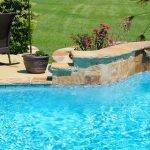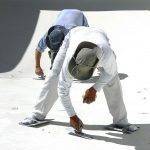There are two reasons to lower your total alkalinity (TA):
1. to slow down the rate that the pH rises, or
2. if high TA is contributing to a high calcium saturation index (CSI) which puts you at risk of calcium scaling.
You do not need to lower TA just to reach a target number. Make sure you actually have one of the above issues before lowering your TA!
The acid/aeration process to lower TA:
- Add acid to lower your pH to between 7.0 and 7.2 (this also lowers TA)
- Aerate until pH rises to around 7.6 (the only way to raise PH without also raising TA)
- Repeat steps 1 and 2 until you reach the desired TA.
You can lower pH with muriatic acid or dry acid (usually labeled as “pH Reducer”). Dry acid should NOT be used in plaster pools or pools with a saltwater chlorine generator (SWG). The sulfates in dry acid can damage concrete & plaster and degrade the coatings on SWG plates. Sulfates can only be removed by draining water.
You can get an estimate of the amount of acid to use with PoolMath. Keep in mind that the amount of acid required can vary from the estimate. If your test kit includes the acid demand test, you can use that to calculate the amount of acid required more precisely. Allow at least 30 minutes after adding acid, with the pump running, before testing the pH again.
Aeration can be provided by a SWG, spa jets, waterfall, fountain, return pointed up so it breaks the surface, air compressor, kids splashing, rain, etc. this one, and this one show examples of home made fountains and this post shows a spa style jet that fits into a return.
Lowering TA can take some time, days or even weeks, depending on the amount of aeration you have and how far you need to lower your TA. Many smaller bubbles are better than a few large bubbles. Lowering the PH back to 7.0-7.2 more frequently will also speed up the process, though that can get tedious.
It is actually the acid which lowers TA. Adding acid lowers both the PH and the TA. Then aeration raises the PH without changing TA. Do not use chemicals to raise your pH during this procedure (unless your pH accidentally goes way too low); that will just raise your TA back up, which is exactly what you are trying to avoid.
There is a common myth that you can lower TA by adding “slugs” of acid to the pool. While any addition of acid, slugs or otherwise, will lower the TA, adding slugs of acid can damage the pool surface and may lower the PH far enough to cause other problems. See this paper for a detailed study showing that this approach does not work any differently than any other way of adding acid.





